Sam found Negative Space to be worth the almost three month wait, while The Spire is starting to lose her interest narratively speaking. Kylee also had one awesome read – the always fantastic Arcadia – and one read that she wishes she could quit. At this point, she’s basically hate-reading Fight Club 2 if only to be able to argue pedantically about it in the future.
Jackson, on the other hand, dug into three series that are really working for him. Read on to see our opinions on all the issues we read in this week’s pull list and be sure to leave your opinions in the comments for us!
Sam’s Reads
Negative Space #2
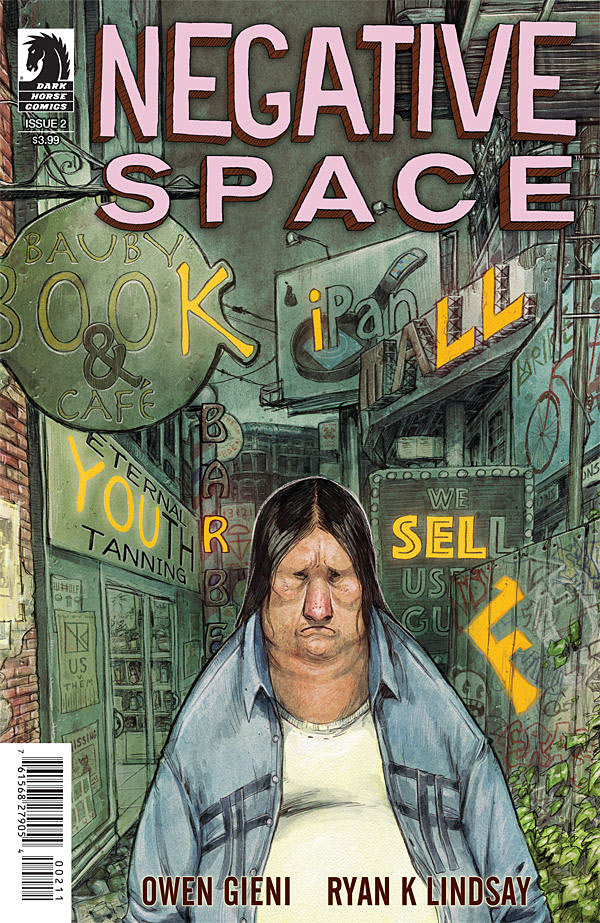

Artist: Owen Gieni
Publisher: Dark Horse Comics
Source: Dark Horse DRC
★★★★☆
It’s taken a good two and a half months but the second issue of Negative Space is finally out. That big of a gap between the first two issues may have made me lose interest a bit but the cliffhanger at the end of the first one left me wondering. It’s a good thing I stuck through with it – this issue goes a lot further in to explaining the mythos behind the Evorah.
Initially underwater beasts of horror, the Evorah discovered how much they loved human sadness by feeding on our tragedies. They teamed up with the founders of the company Kindred to ensure that there was always a constant flow of human misery to feed their insatiable thirst for our depression. They actually built an entire museum dedicated to desperation down in the depths. But it turns out not all of the Evorah feed on sadness. Some, like newcomer Beta, have teamed up with people like Guy’s buddy Woody to fight back. Unfortunately, Kindred is on to them. Fortunately, with the exception of capturing Woody and killing his men, they don’t know how to fight back.
Beta and Guy escape to a secret lair full of happy people who fight back against the Evorah subtly by reaching out to their fellow man in small acts of kindness. But they are done with little acts here and there. They have a new plan: blow up the museum of misery with a happiness bomb. And Guy just so happens to be the one to power it. Of course the plan rests on him powering it with happiness and since he was ten seconds away from suicide last issue… we’ll see how that goes. Unfortunately, we apparently won’t see how that goes until January.
The Spire #3 (of 8)
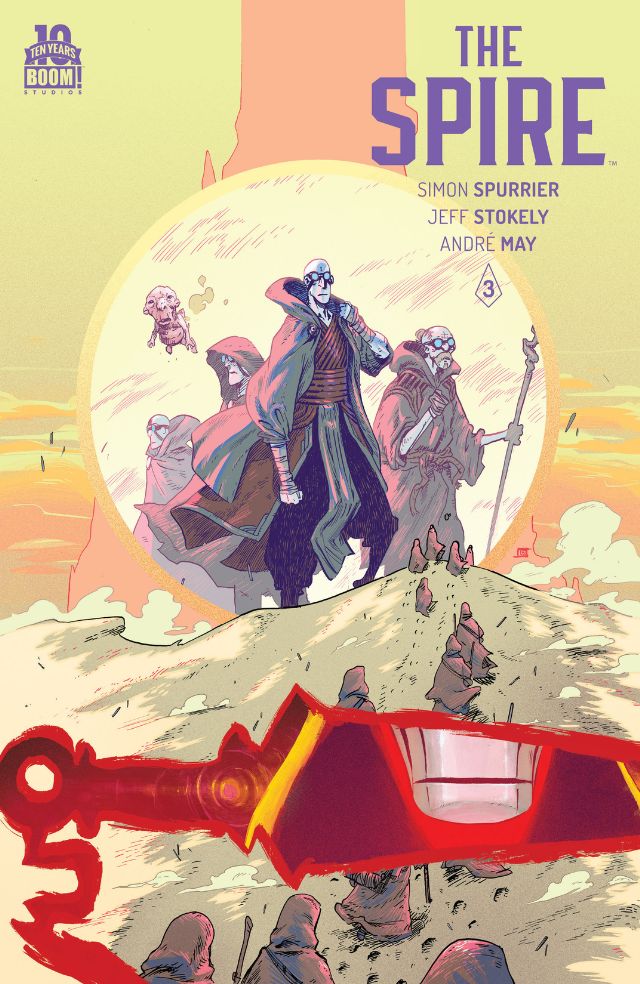

Artist: Jeff Stokely
Publisher: BOOM! Studios
Source: BOOM! Studios DRC
★★☆☆☆
I don’t know why but somehow the magic of this series has started to fade. It’s an interesting concept but the mystery hasn’t really kept my interest. In this issue Pug returns back to the Spire to report to Sha. Apparently all the groups heading towards the Spire were there to renew their commitments to the reigning family and pledge fealty to the new baroness. (Or something, I don’t know.)
In the background, the whole murder mystery deal is still going on. Not that any answers seem to be coming. Instead they go ahead and add another layer to everything, making Sha apparently some unknown, phantom scourge of one of the groups. I mean, we learn a bit more about Sha which is cool – namely her origins are mysterious, her name made up, and her aging significantly slowed considering she’s apparently been on the job a good thirty years or something. (Poor Milk trying to wrap his head around that one.) Plus her relationship with the young baroness remains adorable.
Still quite the stunning book, I’m hoping that the narrative becomes more engaging. Otherwise I might have to drop this one.


Kylee’s Reads
Fight Club 2 #5
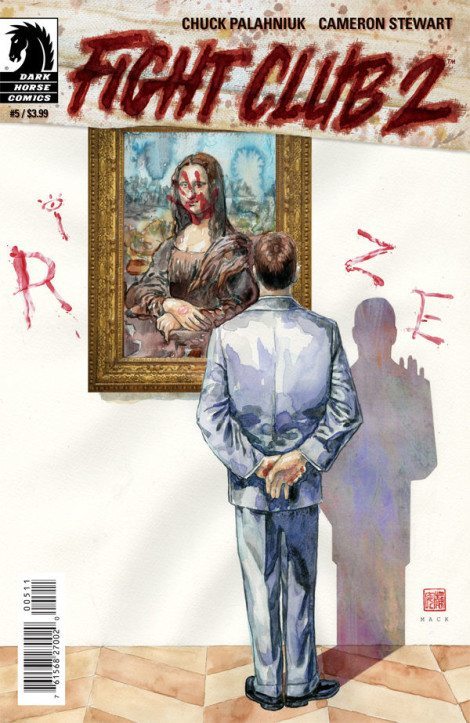

Artist: Cameron Stewart
Publisher: Dark Horse
Source: Dark Horse DRC
★★☆☆☆
Every time I say no more, it’s usually the cover that pulls me back in – David Mack did spectacular work with Fight Club #5 and it lured me into a false sense of hope. Ultimately, the series could boil down to one of my original fears and failures. Delivered in chunks, the story loses most of its power. Did you care about Sebastian and Marla’s son for the issues he was missing? Did you even remember that this all started because of him? Not really.
The short vignettes checking in with various characters made this issue feel even shorter than previous issues, stagnating the story further into something clearly fan-service-y. We learn that Marla wasn’t an OG support group crasher in her update, as well as catching a surreal glimpse of bitch tits while in the ridiculous war zone she’s in. It’s a familiar reference that book and movie fans will recognize in the same way they might remember Angelface just in time to see him brutalized again.
Beyond that, it’s almost more of the same – Sebastian and Tyler are at odds with each other, with Sebastian medicating himself into oblivion. What was a neat parlor trick of fourth wall breaks with the pills has become tired and cheap even as Stewart’s cartoonish style continues to serve its purpose. Like my complaints about previous issues, there’s very little forward momentum as we hit the halfway point of the series and worse, it’s becoming formulaic. Resting on nostalgia is only going to take this sequel so far and at this point it’s just dragging a beaten space monkey behind it…
Arcadia #5
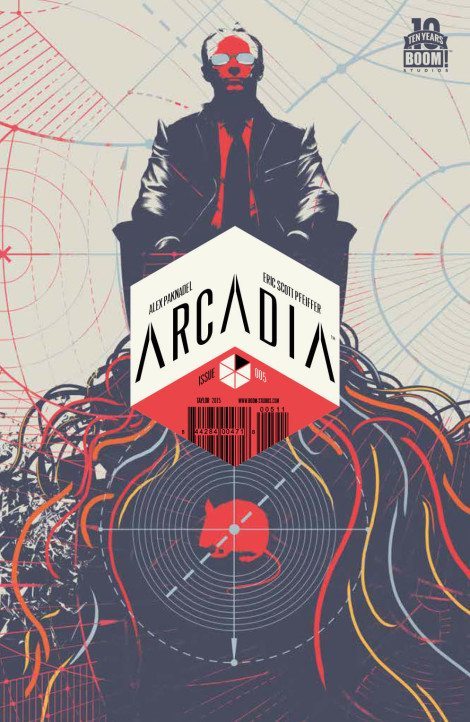

Artist: Eric Scott Pfeiffer
Publisher: BOOM! Box
Source: BOOM! Studios DRC
★★★★★
With the kickoff of a new story arc, we say goodbye to Matt Taylor, who has been doing the covers for Arcadia, though I’ve been promised at least one more surprise on the way from him.
The Meat find themselves at odds with Arcadia and President Binetti is performing ‘miracles’ that overload the servers now that he has the root password. Lee Pepper is encouraged to head to California – a dangerous place for reasons yet known – to start sorting things out in reality.
Meanwhile Coral and the group of Homesteaders are left to figure out what they can do with her brother and are pushed into acting before they’ve fully figured it out. Eric Scott Pfeiffer’s art lends itself particularly well to the layers of Arcadia that Giacomo must pass through to get to the heart of it. This may be my favorite issue as far as the artwork is concerned. Pfeiffer takes a particularly reserved stance for these discovered parts of Arcadia that help to set the mystical, wistful tone of what the intention of Arcadia might have once been.
Alex Paknadel continues to dream big narratively speaking, while giving sparse answers to questions already raised, and it has yet to backfire on him. A question of ethical standards and what makes a person a person has morphed into a political drama rooted in literal life and death. You’d think unplugging the servers would solve The Meat’s most recent problems with Arcadia and President Binetti, who is revealed to already have a cure for the ailment that led to the creation of Arcadia in the first place, but rarely are things that simple.
As always, Arcadia #5 is layered, chaotic, and fantastic in posing unique questions in the best new science fiction series released this year.


Jackson’s Reads
Nameless #5
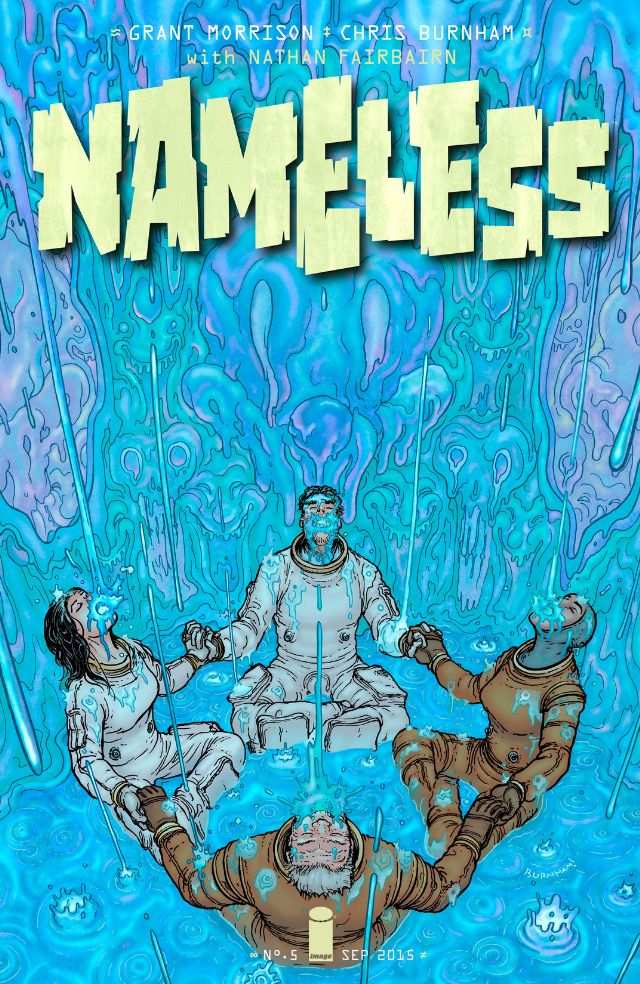

Artist: Chris Burnham
Publisher: Image Comics
★★★★☆
Do you ever get a splinter that you can’t quite remove? The cut in your mouth you can’t quite ignore? Had that little embarrassment you never quite manage to totally forget? Those tiny, painful little things can ultimately become all-consuming, a problem that has to be solved, has to be examined by any means necessary. It becomes an evil all to itself. In a way, that’s Grant Morrison and Chris Burnham’s Nameless, a haunting, recurring dream of death and madness needling its way into your consciousness.
This week’s Nameless #5 spends most of its time on a memory from the titular character’s past, when he was hired to study the 17-sided-key that investigators believe may be a remnant from the Fear Star, which is rocketing closer and closer to Earth in the present. Like many of Morrison’s independent books, Nameless deals in complex metaphor and repeated, memetic imagery.
Here, he draws attention to recurring, oft-religious symbols, namely the classic haunted house, an eight-sided, connecting semi-infinite sign, the Tree of the Knowledge of Good and Evil, the tesseract and an uneven cross. Most of these are used obliquely, namely with the tree in this issue serving as a crucifix and an unfolded cube giving way for unleashing something unimaginably horrific into the material plane.
While most of the horror in Nameless has had that same, measured mysteriousness, this week’s issue is overtly disturbing. One character’s eyes and lips are cut off as he’s crucified in the midst of a rain of razor blades. Another disturbing panel shows someone’s finger nails being graphically ripped from their digits. One panel shows the after-effects of performing dental surgery with barbed wire. All are flashes, small bits of Morrison and Burnham’s larger horrific tapestry, all sure to haunt you, like that nasty hangnail, that bothersome cankersore, that one memory you can never quite purge.
Years of Future Past #5
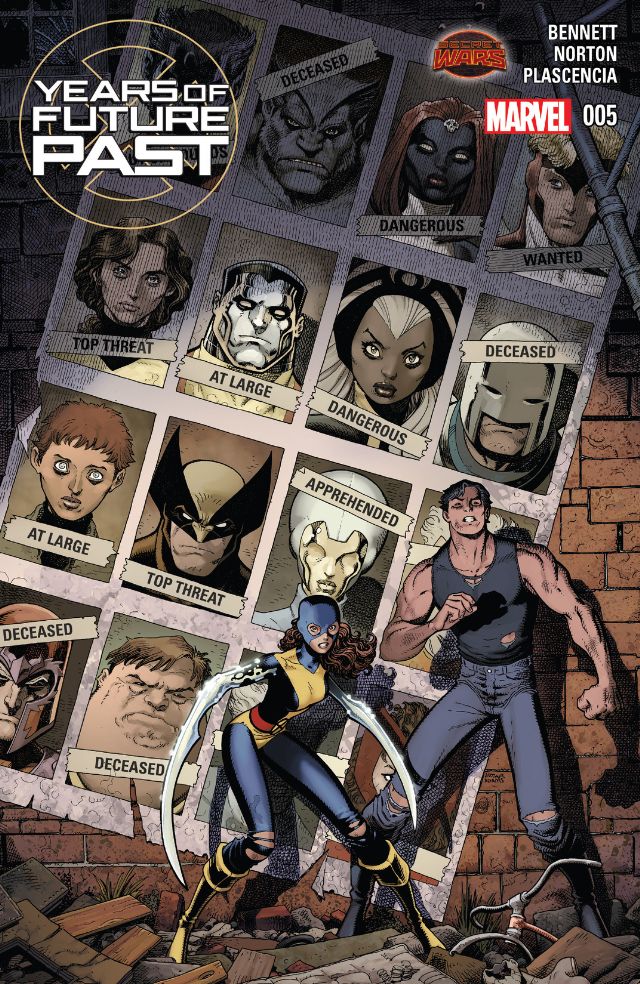

Artist: Mike Norton
Publisher: Marvel Comics
★★★★☆
Years of Future Past #5 is the rare comic that asks whether the mutant race is worth saving and doesn’t offer an answer. There’s going to be two notable arguments that can be made around this situation and, really, around this series’ ambiguous ending. On the one hand, every X-Men story is generally about the value of preserving something special, keeping alive a people and a culture who are constantly under attack by nature of the characters and lives they highlight.
They implicitly say the mutants have to be worth saving because these are the characters you’re reading about, the ones you like, and the ones you buy these comics for. On the other hand, however, writer Marguerite Bennett’s barely writing an X-Men story here. She’s not interested in making the X-Men heroes or the mutant’s as a race something worth defending. She’s written a story about whether or not killing is an act of mercy. It’s a much scarier, much more interesting question in an X-Men story and one we as readers are asked much less often.
Siblings Christina and Cameron Pryde come to blows in this issue over whether mutants can or deserve to survive and while that fight takes up the majority of the issue, what’s more interesting are the last pages, the ones more interested in examining the X-Men falling into their old tired roles. Wolverine’s going to keep fighting and so are Kitty and Piotr but artist Mike Norton draws them all with a sense of real road-wariness, creases that haunt their faces, swaying fists that have seen too much blood.
That sense of survival for the sake of survival, that total lack of hope, is going to be a gut punch for X-Men fans like myself who’ve seen these characters through tragedy after tragedy but there’s something fitfully, painfully real about the portrayal here. Even if the last page is a bit of a dramatic let-down, this is one of the few Secret Wars tie-in stories that will be remembered for a long time to come.
We are Robin #4
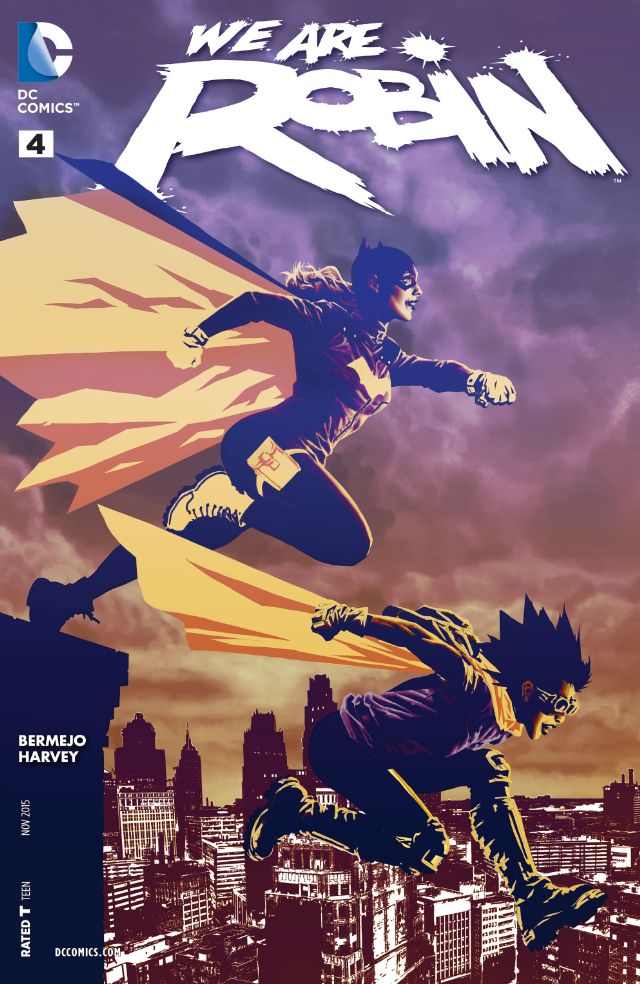

Artist: James Harvey
Publisher: DC Comics
★★★★★
When Robin was created, he was meant to serve both as a point of entry character, and more importantly, the character young readers were meant to personally connect to. Bill Finger wanted boys in 1940 to imagine themselves as “The Boy Wonder,” Batman’s pal and partner in fighting for justice and right. Robin’s role as Batman’s partner and his role to readers has changed in the seven decades since and what’s interesting in the last 25 years or so is how Robin has become a personification of fandom. Since Tim Drake’s introduction in 1989, Robin has represented passionate love for Batman as a concept, that desire to know everything about the caped crusader, wanting to do everything you can to make the world a better place, just like your hero does.
We are Robin, in a lot of ways, is about Batman as an aspirational force but this week’s issue #4 is explicitly about Batman as a cultural sensation and consumer product. The issue focuses on computer expert Riku, who’s been on the auxiliary of the last issues of the series. Here, she goes to school after Troy’s death and tries to deal with her pain as well as her mounting desire to embrace her passions by putting on the tights and cape once again.
So much of We Are Robin #4 is about the all consuming force of being a fan, the way it warps your thoughts, consumes your free time and, in so many ways, becomes a nurturing place for you to be yourself. So much of the success in establishing this feel goes to artist James Harvey who populates page after page with eye numbing detail.
He designs Riku as a school-girl more interested in putting herself at odds with her fellow students than being friends with them and the ways Harvey illustrates her classroom, an empty, desolate space, versus her room, one crammed with posters and Batman kitsch, is fantastic and familiar to anyone who found safety in fandom. He also brilliantly shows the aspirational relationship between Batgirl and Riku, one already safely in the public hearts and mind and the other desperate for the same recognition but not sure of the cost that entails. It’s a wonderful tribute to the recent makeover for Barbara Gordon but it’s an even better portrayal of how much these characters mean to fans.
That attention to detail and knowledge of what DC’s characters mean to their own fictional world and their own fans is powerful and wonderful to see portrayed. As someone who found safety and happiness in these characters in the same way Riku and some of the other Robins have, it’s wonderful to see DC recognize exactly the relationship between their heroes and their biggest fans. Even without that message, Lee Bermejo and Harvey create an intoxicating world in this issue, something at once realistic and cartoony, silly and achingly heartfelt, a little naive and painfully knowing. It’s a balancing act rarely pulled off well and it makes for one of 2015’s very best comics.

